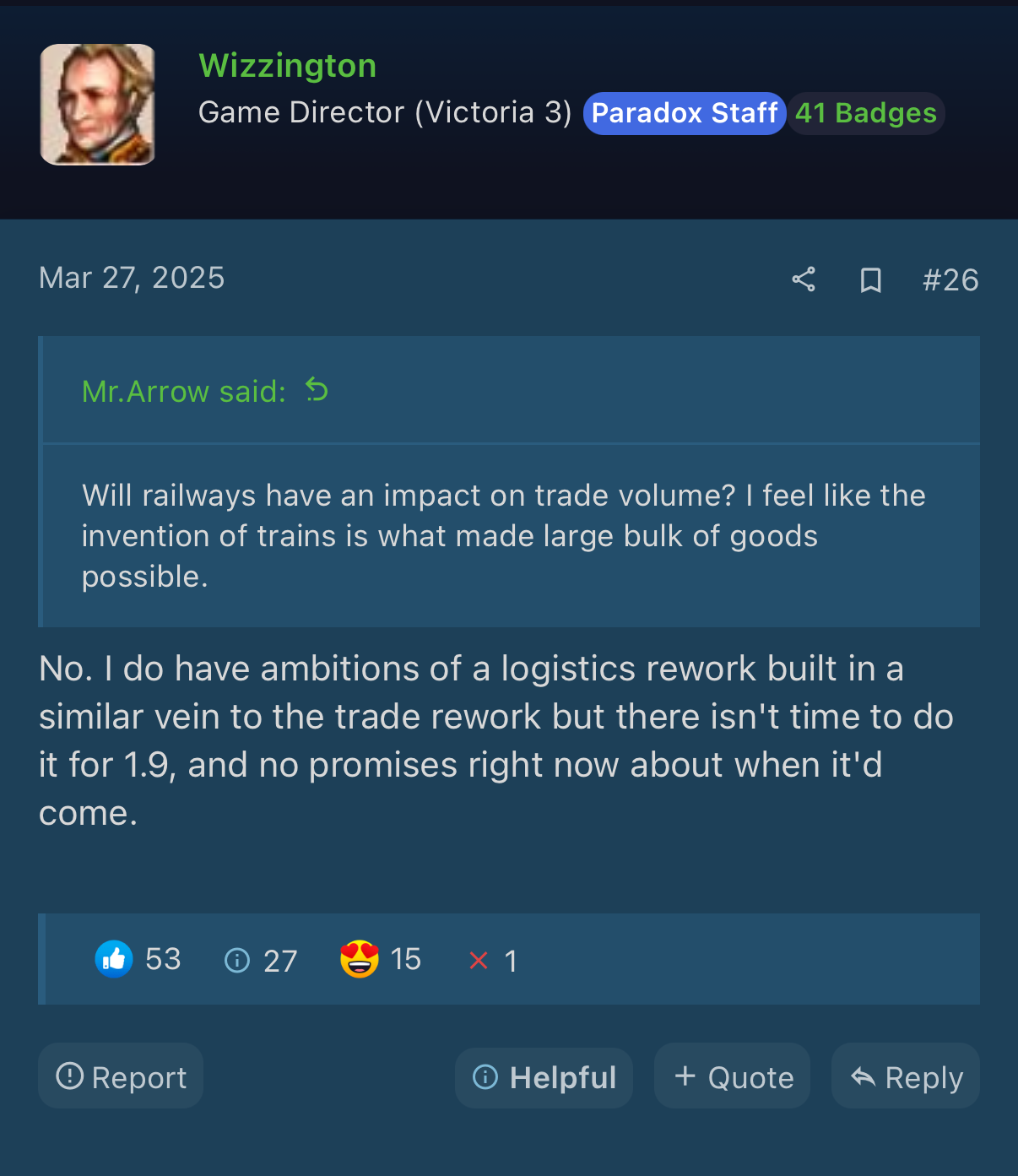Reading the recent DD on the trade rework, something struck me as strange for trade centers: the lack of transportation usage.
This makes sense if they are on coastal states, as that would be the new merchant marine good, but on an inland one?
No, they need to get those goods to the coast somehow before the MM can take it to the world market.
But they do use infrastructure, which is what the game uses to represent this I guess.
Problem is, infrastructure is free, while transportation is not. This creates issues, especially for railways, where buildings are using their output for free, making them unprofitable while still very much necessary.
Labor saving PMs for transportation are very odd in this regard too. Their only effect for the building is to save labor, but with them deactivated the building is still using railways (or the infra they create) for free.
Ideally, labor saving PM should use transportation even on the first level (with the amount increasing as you decrease the required laborers).
To compensate, peasant farms should also produce some token amount of transportation, and maybe even give urban centers a boost to their transportation PMs, representing the infra source from population. State traits, tech and other modifiers could give a throughput bonus here as well.
Automobiles by themselves shouldn't give infra, but be used in the last levels of the labor saving PM. Pops would still consume them as usual though.
(Obs: this would make automobiles very good at saving labor, as not only would they be on a labor saving PM, they'd also reduce the demand for transportation, making railways less profitable, firing people and downsizing in the process).
Essentially, wherever there's infra usage, there should also be transportation input to go with it.
This would create a more or less direct correlation between infra and transportation, where low market access implies a high cost of transportation, being very low access where there's a shortage.
My problem with the way it is now, is that there are a lot of goods being transported essentially for free, the trade center case just made it more clear to me.
Am I missing something here? Or does someone else also feels the same?
This makes sense if they are on coastal states, as that would be the new merchant marine good, but on an inland one?
No, they need to get those goods to the coast somehow before the MM can take it to the world market.
But they do use infrastructure, which is what the game uses to represent this I guess.
Problem is, infrastructure is free, while transportation is not. This creates issues, especially for railways, where buildings are using their output for free, making them unprofitable while still very much necessary.
Labor saving PMs for transportation are very odd in this regard too. Their only effect for the building is to save labor, but with them deactivated the building is still using railways (or the infra they create) for free.
Ideally, labor saving PM should use transportation even on the first level (with the amount increasing as you decrease the required laborers).
To compensate, peasant farms should also produce some token amount of transportation, and maybe even give urban centers a boost to their transportation PMs, representing the infra source from population. State traits, tech and other modifiers could give a throughput bonus here as well.
Automobiles by themselves shouldn't give infra, but be used in the last levels of the labor saving PM. Pops would still consume them as usual though.
(Obs: this would make automobiles very good at saving labor, as not only would they be on a labor saving PM, they'd also reduce the demand for transportation, making railways less profitable, firing people and downsizing in the process).
Essentially, wherever there's infra usage, there should also be transportation input to go with it.
This would create a more or less direct correlation between infra and transportation, where low market access implies a high cost of transportation, being very low access where there's a shortage.
My problem with the way it is now, is that there are a lot of goods being transported essentially for free, the trade center case just made it more clear to me.
Am I missing something here? Or does someone else also feels the same?
- 10
- 1



